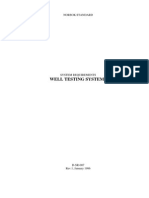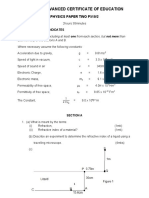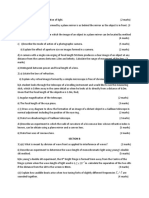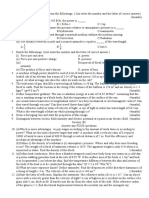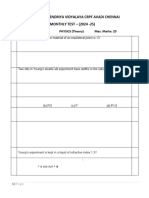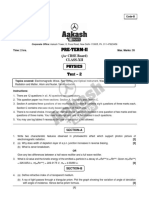P510/2 Physics Paper 2 Jul/ Aug 2018 3 Hours: Mukono Examination Council 2019
P510/2 Physics Paper 2 Jul/ Aug 2018 3 Hours: Mukono Examination Council 2019
Uploaded by
crazekeith256Copyright:
Available Formats
P510/2 Physics Paper 2 Jul/ Aug 2018 3 Hours: Mukono Examination Council 2019
P510/2 Physics Paper 2 Jul/ Aug 2018 3 Hours: Mukono Examination Council 2019
Uploaded by
crazekeith256Original Title
Copyright
Available Formats
Share this document
Did you find this document useful?
Is this content inappropriate?
Copyright:
Available Formats
P510/2 Physics Paper 2 Jul/ Aug 2018 3 Hours: Mukono Examination Council 2019
P510/2 Physics Paper 2 Jul/ Aug 2018 3 Hours: Mukono Examination Council 2019
Uploaded by
crazekeith256Copyright:
Available Formats
P510/2
PHYSICS
Paper 2
Jul/ Aug 2018
3 Hours
MUKONO EXAMINATIONS COUNCIL
Uganda Advanced Certificate of Education
PHYSICS
Paper 2
3 Hours
INSTRUCTIONS TO CANDIDATES
Answer five questions, including at least one from each section, but not more than one from any
of the sections A and B.
Where necessary assume the following constants:
Acceleration due to gravity, g = 9.81ms-2
Speed of light in vacuum, c = 3.0 x 108ms-1
Speed of sound in air v = 340ms-1
Electronic Charge, e = 1.6 x 10-19C
Electronic mass, me = 9.1 x 10-31kg
Permeability of free space, μ0 = 4.0π x 10-7Hm-1
Permittivity of free space, ε0 = 8.85 x 10-12 Fm-1
1
The Constant, = 9.0 x 109F-1m
4 π ε0
Mukono Examination Council 2019 Page 1
SECTION A
1.(a) Define principal focus of a concave lens. (1mark)
(b) (i) Show that the focal length, f, of a convex lens can be given by
1 1 1
= (n-1) ( + ), where n is the refractive index of the material of the lens, and r 1,
f r1 r 2
r2, are the radii of curvature of the lens surfaces. (4marks)
(ii) A diverging meniscus of focal length 115.4cm, is made of material of refractive index
1.52. If the radius of curvature of its concave surface is 12cm, find the radius of
curvature of the other surface. (3marks)
(c) Describe how you can determine the refractive index of a transparent liquid using a
convex lens of known radii of curvature and plane mirror. (6marks)
(d) (i) Draw a ray diagram to show the image formation by Galilean telescope with the final
image at the near point. (2marks)
(ii) A Galilean telescope is used to focus a distant object with the eye piece placed 50cm
from the objective lens. The focal lengths of the objective and the eye piece are 100cm
and 10cm respectively. Find the distance of the final image from the objective lens.
(3marks)
(iii) Describe one disadvantage of a Galilean telescope. (1mark)
2. (a)(i) Define principal focus of a convex mirror. (1mark)
(ii) Using a convex mirror, derive the mirror formula. (5marks)
9
(b) A concave mirror forms an inverted image times the size of the object, when the object
5
is placed in front of it. When the object is moved 18cm towards the mirror, the image
formed is upright and three times the size of the object. Find the:
(i) focal length of the mirror. (4marks)
(ii) displacement of the image. (3marks)
(c) With the aid of a sketch ray diagram, describe how a prism binocular works. (4marks)
(d) (i) What is accommodation as applied to vision by the eye? (1mark)
(ii) Explain why when two poles of equal height are placed at different points in line with
the observer they appear to differ in size. (2marks)
SECTION B
3 (a) (i) List two differences between mechanical and electromagnetic waves. (2marks)
Mukono Examination Council 2019 Page 2
(ii) Describe a simple experiment to show that sound is a mechanical wave. (4marks)
(b) (i) What are harmonics as applied to sound notes? (1mark)
(ii) Show that the frequency of the nth harmonic produced by an open pipe of length, l , and
end correction, e, is given by
nV
fn = , where V is the velocity of sound in air. (3marks)
2(l+2 e)
(iii) Explain why two open pipes of the same length may produce fundamental notes of
different frequencies. (3marks)
(c)(i) A car moving towards a high cliff passes a stationary observer with a speed of
18km/h, while sounding a horn of frequency 205Hz. If the velocity of sound at the time
is 340m/s, find the frequency of beats head by the observer. (4marks)
(ii) Describe one application of Doppler Effect. (3marks)
4. (a) What are coherent sources of waves? (1mark)
(b) Explain how two coherent sources are obtained
(i) using a bi-prism. (2marks)
(ii) using Lloyd’s mirror. (2marks)
(c) (i) Two coherent sources of waves a distance, d, apart produce light of wavelength, λ ,
which interfere on a screen, a distance, D, from the source forming an interference
λD
pattern. Show that the width, x, of each fringe is given by x = . (4marks)
d
(ii) Two glass slides in contact at one end are separated by a sheet of paper 15cm from the
line of contact, to form an air wedge. When the air wedge is illuminated almost
normally by light of wavelength 600nm, interference fringes of separation 1.8mm are
formed. Find the thickness of the paper. (4marks)
(d) (i) Describe how plane polarised light can be produced by double refraction. (4marks)
(ii) Describe briefly one application of plane polarised light. (3marks)
SECTION C
5 (a) What are magnetic field lines and magnetic field strength? (2marks)
(b) (i) With the aid of a sketch diagram of magnetic field pattern due to two wires carrying
currents in opposite directions, explain why force acts between the wires. (3marks)
(ii) A rectangular coil of, N, turns, length, l, and width, w, carrying current, I, is placed in a
uniform magnetic field of flux density, B, with its plane parallel to the field. Derive the
expression for the torque on the coil. (4marks)
Mukono Examination Council 2019 Page 3
(c) What is magnetic meridian and angle of dip? (2marks)
(d) Describe how you can determine the horizontal component of the earth’s magnetic flux
density using a deflection magnetometer. (4marks)
(e) A vertical wire of length 15cm carries current of 5A in a plane where the earth’s total
intensity is 54.2Am-1. If the angle of dip at the location is 49.50, find the
(i) force experienced by the wire. (3marks)
(ii) Vertical component of the field strength. (2marks)
6 (a) State the laws of electromagnetic induction. (2marks)
(b) A coil of 100turns is wound round the middle of a long solenoid of 500turns per metre
and radius 8.0cm. A sinusoidal current of I = 10sin(120 πt ¿ ,amperes is passed through
the solenoid winding. Find the amplitude of the emf induced across the terminals of the
coil. (5marks)
(c) (i) With the aid of a diagram, describe how a simple d.c motor works. (5marks)
(ii) Explain the term back emf in a motor and derive its relation to the efficiency of the
motor. (3marks)
(iii) When a motor is connected to a supply voltage of 210V and is running freely, the
supply current is 3.0A. If the motor is 97% efficient, find the armature resistance.
(2marks)
(d) Briefly explain one application of eddy currents. (3marks)
7. (a) (i) Why is alternating current referred to as sinusoidal? (1mark)
(ii) Derive the expression for the average power dissipated in a resistor when a sinusoidal
current is passed through it. (3marks)
(b) (i) A current of I = Io sin 2 πft is supplied in a circuit containing a capacitor of capacitance,
C. Derive the expression for the p.d across the capacitor. (2marks)
(ii) Draw on the same axes graphs showing the variations of voltage across the capacitor
and the current supplied against time. (2marks)
(iii) Explain the phase relationship between the current and voltage in b(i) above.
(2marks)
(c) (i) Describe how a hot wire ammeter works. (4marks)
(ii) List the differences in the principle of operation of the ammeter in c(i) above with a
repulsion type of ammeter. (3marks)
(d)(i) Define the term impedance. (1mark)
Mukono Examination Council 2019 Page 4
(ii) A pure inductor of inductance 15mH is connected in series with a resistor of 3.0Ω,
across an a.c mains of frequency 50Hz. Determine the impedance of the circuit.
(3marks)
SECTION D
8 (a) (i) Draw the I – V characteristic graphs for filament lamp and semi – conductor diode.
(2marks)
(ii) Explain the features in the graphs in a(i) above. (3marks)
(b) (i) outline the principle of operation of a slide wire potentiometer. (3marks)
(ii) Describe an experiment to determine the emf of a thermo – couple using a
potentiometer. (5marks)
(c)
In figure 1, the cells of 2V and 1.5V have negligible internal resistance. If the centre zero
galvanometer, G, shows no deflection, find the value of resistance, Y. (4marks)
(d) A coil of wire has resistance of 35Ω at 280C and 37.4Ω at 500C. Calculate the
temperature coefficient of resistance of the wire. (3marks)
9. (a) State Coulomb’s law of electrostatics. (1mark)
(b)
Mukono Examination Council 2019 Page 5
Charges of +30µC, -2.8µC, +7µC and +2.5µC are placed in a straight line in air as above.
Find the;
(i) Force acting on the +2.5µC charge. (4marks)
(ii) Electric potential energy of the -2.8µC charge. (3marks)
(c) (i) Explain why the potential of a positively charged body reduces when a neutral
conductor is brought near it. (3marks)
(ii) A gold leaf electroscope is positively charged and isolated. When a thumb pin is
placed on the cap of the electroscope with its pointed end facing away, the leaf of the
electroscope is seen to collapse after a short time. Explain this observation. (2marks)
(d) (i) Describe how a Van de Graaff generator works. (6marks)
(ii) Account for the energy stored in the generator. (1mark)
10. (a) (i) Define capacitance of a capacitor. (1mark)
(ii)
Figure 3, is a network of three identical capacitors of capacitance, C, Show that when a
dielectric of relative permittivity εr is inserted in the capacitors R and P, the total capacitance
( 2+ ε r ) ε rC
in the network becomes .
(1+ε r )
(3marks)
(b) (i) Describe how you would determine capacitance of a capacitor. (4marks)
(ii) State two uses of a dielectric in a capacitor. (1mark)
(c) Two capacitors of capacitances 16µF and 20µF are connected in series and charged by a
battery of 40V. The two capacitors are then connected across an uncharged capacitor,
B, of capacitance 8µF, and then the plates of B are filled with a dielectric of relative
permittivity 1.5.
Calculate :
(i) the final p.d across B. (4marks)
(ii) the final energy stored in the network. (3marks)
Mukono Examination Council 2019 Page 6
(d) Explain how placing a dielectric between the plates of a capacitor changes the capacitance.
(4marks)
End -
Mukono Examination Council 2019 Page 7
You might also like
- Matigo Pre Mock Physics Pp2 2024Document7 pagesMatigo Pre Mock Physics Pp2 2024vincentnorbert05No ratings yet
- Well Testing Recommended PracticesDocument40 pagesWell Testing Recommended Practicessajithv78100% (1)
- Physics Paper 2 June 2024 SLECKDocument7 pagesPhysics Paper 2 June 2024 SLECKHerbert LandaNo ratings yet
- Uganda Advanced Certificate of Education: Physics Paper Two P510/2Document9 pagesUganda Advanced Certificate of Education: Physics Paper Two P510/2ssempijja jamesNo ratings yet
- P510/2 Physics Paper 2 July/August 2 / HoursDocument8 pagesP510/2 Physics Paper 2 July/August 2 / HourszakNo ratings yet
- St. Joseph'S Ss Kakindu: Uace Resource Mock ExaminationsDocument10 pagesSt. Joseph'S Ss Kakindu: Uace Resource Mock ExaminationsAinebyoona ChriscentNo ratings yet
- Ereta Uace Physics 2 FinalDocument9 pagesEreta Uace Physics 2 Finalnamatajenn692No ratings yet
- P510/2 Physics JULY 2012 Paper2Document8 pagesP510/2 Physics JULY 2012 Paper2Mutsyaba Victor JuniorNo ratings yet
- UACE KCB MOCK Phy2 PDFDocument8 pagesUACE KCB MOCK Phy2 PDFTRIPPLE KAYZ UGNo ratings yet
- Turkish Light Academy Uganda Advanced Certificate of EducationDocument6 pagesTurkish Light Academy Uganda Advanced Certificate of EducationMutsyaba Victor JuniorNo ratings yet
- UACE Physics 2Document7 pagesUACE Physics 2zawayarobert45100% (2)
- Physics Seminar IIDocument9 pagesPhysics Seminar IImundu mustafaNo ratings yet
- Resourceful Mock Examinations 2020: PhysicsDocument9 pagesResourceful Mock Examinations 2020: PhysicsKawesa MustaphaNo ratings yet
- S.6 Physics Revision Questions - 2020Document83 pagesS.6 Physics Revision Questions - 2020Kizito JohnNo ratings yet
- PHYSICS P2 To Be Done On 26th MarchDocument7 pagesPHYSICS P2 To Be Done On 26th MarchsykehanscyphaNo ratings yet
- PHY2 MOCK 2024 TEADocument5 pagesPHY2 MOCK 2024 TEAoyetgeoffrey123No ratings yet
- King'S College, Budo Physics Seminar - 15 JUNE, 2019 Paper 2 QuestionsDocument20 pagesKing'S College, Budo Physics Seminar - 15 JUNE, 2019 Paper 2 Questionsfahadsserubiri8No ratings yet
- Phy 2-2017Document4 pagesPhy 2-2017Eremu ThomasNo ratings yet
- P510/2 Physics Paper 2Document6 pagesP510/2 Physics Paper 2Java JimmyNo ratings yet
- Ch9-10 CBSE 2023Document4 pagesCh9-10 CBSE 2023tebor93898No ratings yet
- S.5 Phy P2Document8 pagesS.5 Phy P2kaziba stephenNo ratings yet
- Question Bank Phy P510-2 (1993-2012) .Document102 pagesQuestion Bank Phy P510-2 (1993-2012) .Tumusiime osagyefo Johnbosco Adyeeri100% (2)
- Physics IiDocument4 pagesPhysics IiNtirnyuy LeenaNo ratings yet
- MATIGO MOCKS UACE PHY 2 2023-1Document7 pagesMATIGO MOCKS UACE PHY 2 2023-1makumbim2No ratings yet
- Weekly Revesion Test No.3, 5mark QuesDocument4 pagesWeekly Revesion Test No.3, 5mark QuesGokul thennarasuNo ratings yet
- (PHT100) Phy A, Dec 2021Document3 pages(PHT100) Phy A, Dec 2021adithyan sreeniNo ratings yet
- EP Question Bank MT1Document2 pagesEP Question Bank MT1thetop10nerdNo ratings yet
- PhysicsDocument3 pagesPhysicsshanizsybillNo ratings yet
- Physics IDocument4 pagesPhysics INtirnyuy Leena100% (1)
- (PHT100) Phy A, July 2021Document2 pages(PHT100) Phy A, July 2021adithyan sreeniNo ratings yet
- Mock Ext P2 For S6 2019Document8 pagesMock Ext P2 For S6 2019Mungujakisa HerbertNo ratings yet
- Physics - I (PH 1110)Document3 pagesPhysics - I (PH 1110)Kappagantu Vinay KumarNo ratings yet
- 256d98b22018 MID SEMDocument2 pages256d98b22018 MID SEMAnkit BishtNo ratings yet
- s.5 Physics Paper 2 E.O.TDocument3 pagess.5 Physics Paper 2 E.O.TmatugahighNo ratings yet
- MOCK EXT P2 For S6 2017Document8 pagesMOCK EXT P2 For S6 2017princecalvinthegreatNo ratings yet
- Grade 11 Old CurriculumDocument2 pagesGrade 11 Old CurriculumYan KyawNo ratings yet
- New August Mt Qp Xii PhysicsDocument2 pagesNew August Mt Qp Xii Physicssandhiya11476No ratings yet
- Adobe Scan 24-Mar-2022Document3 pagesAdobe Scan 24-Mar-2022Aabin Joseph JohnNo ratings yet
- Physics 1st YearDocument3 pagesPhysics 1st YearzzarghamNo ratings yet
- Phys12sqp - 2Document3 pagesPhys12sqp - 2ShreeNo ratings yet
- P2 S6 Test Phy Paper IIDocument3 pagesP2 S6 Test Phy Paper IIabrahambyomuhangi1No ratings yet
- Phy-131.2 F6 MZUMBEDocument7 pagesPhy-131.2 F6 MZUMBENestory mahunjaNo ratings yet
- Class: XII Session: 2020-2021 Subject: Physics Sample Question Paper (Theory)Document11 pagesClass: XII Session: 2020-2021 Subject: Physics Sample Question Paper (Theory)Kavisha ChintamaniNo ratings yet
- PHT100 Engineering Physics A, December 2019Document3 pagesPHT100 Engineering Physics A, December 2019Jayapal AsNo ratings yet
- Standard High School Zzana: P510/2 Physics Paper 2Document8 pagesStandard High School Zzana: P510/2 Physics Paper 2Kitone A Ndrew100% (3)
- NAME .ADM CLASS : 2022 Form 3 Term 1 Opener Exam - (April 2022)Document6 pagesNAME .ADM CLASS : 2022 Form 3 Term 1 Opener Exam - (April 2022)Benjamin mwanikiNo ratings yet
- Phy 2 Military 2024Document7 pagesPhy 2 Military 2024sam2jbegNo ratings yet
- s.5 Phy Paper 2 Test 3Document5 pagess.5 Phy Paper 2 Test 3benjafileNo ratings yet
- CBSE Class 12 Physics Sample Paper Term 2 For 2021 22Document4 pagesCBSE Class 12 Physics Sample Paper Term 2 For 2021 22SUBHAM WORLDNo ratings yet
- Phy F3 Et2 PP2 MSDocument8 pagesPhy F3 Et2 PP2 MSbettabuu1No ratings yet
- Aissce Asgnmt CH-10,11,12,13Document12 pagesAissce Asgnmt CH-10,11,12,13sumitsagar2405No ratings yet
- CLASS XII Physics Preboard Term 2 FinalDocument4 pagesCLASS XII Physics Preboard Term 2 FinalParth SharmaNo ratings yet
- Wave Optics Pyq 2023Document10 pagesWave Optics Pyq 2023Likitha DashNo ratings yet
- S4 Physics ExercisesDocument12 pagesS4 Physics ExercisesMUKIZA ISAACNo ratings yet
- 2022sem II - PHSH - CC4Document2 pages2022sem II - PHSH - CC4Řůpäm ŔøýNo ratings yet
- Physics (OL1) (3rd) Dec2017Document1 pagePhysics (OL1) (3rd) Dec2017AmitNo ratings yet
- S.6 Physics Mid TermDocument4 pagesS.6 Physics Mid Termsserunjojij4No ratings yet
- Pre-Term-Ii: (For CBSE Board) Class-Xii PhysicsDocument3 pagesPre-Term-Ii: (For CBSE Board) Class-Xii PhysicsBadAss GamingNo ratings yet
- S.5 Physics 2Document5 pagesS.5 Physics 2muhangi emmanuelNo ratings yet
- O level Physics Questions And Answer Practice Papers 2From EverandO level Physics Questions And Answer Practice Papers 2Rating: 5 out of 5 stars5/5 (1)
- NTPC Unchahar Team Welcomes You All INDocument33 pagesNTPC Unchahar Team Welcomes You All INashishNo ratings yet
- Vernacular ArchitectureDocument8 pagesVernacular ArchitectureSameer AnsariNo ratings yet
- Elantra 2005 2.0LDocument276 pagesElantra 2005 2.0LSergio RocaNo ratings yet
- How Elevators Work: Kinds, Functions, MechanismsDocument26 pagesHow Elevators Work: Kinds, Functions, MechanismsTrehmani001No ratings yet
- Introduction To Langmuir Probes - Hiden Analytical Tech Info Sheet531Document8 pagesIntroduction To Langmuir Probes - Hiden Analytical Tech Info Sheet531alexaNo ratings yet
- Outdoor Ventilation Airflow Calculations: ControlDocument6 pagesOutdoor Ventilation Airflow Calculations: ControlAli HabibNo ratings yet
- MMMDocument32 pagesMMMNihar ParekhNo ratings yet
- Gravity Teacher Guide PDFDocument56 pagesGravity Teacher Guide PDFThuran Nathan100% (1)
- Yanmar 3tnv82a Bpms Engine Parts Sec WatDocument4 pagesYanmar 3tnv82a Bpms Engine Parts Sec Watapril98% (62)
- Proposal SampleDocument21 pagesProposal SampleMarvin Bandales100% (1)
- D - F Block ElementsDocument30 pagesD - F Block ElementssurjyapravaNo ratings yet
- Industrial Waste TreatmentDocument693 pagesIndustrial Waste Treatmentfacundo koss100% (1)
- Ped Guidelines PDFDocument261 pagesPed Guidelines PDFariffabusemanNo ratings yet
- Simultaneous Heat and Mass Transfer (SHMT) : CHE-402 Date: 08/11/2016Document23 pagesSimultaneous Heat and Mass Transfer (SHMT) : CHE-402 Date: 08/11/2016Atif MehfoozNo ratings yet
- November 2020 Question Paper 12 PDFDocument20 pagesNovember 2020 Question Paper 12 PDFBrandon LawyNo ratings yet
- Sampling OverviewDocument5 pagesSampling OverviewMohdFikhriMohdLatiff100% (1)
- Health, Safety and Environment (Hse) CGE653 Assignment: Fire and Explosion PO5, CO2, C4Document4 pagesHealth, Safety and Environment (Hse) CGE653 Assignment: Fire and Explosion PO5, CO2, C4LouisNo ratings yet
- Tulsa Gas Technologies India Pvt. LTD: Data Sheet For 37 KW CNG Booster CompressorDocument6 pagesTulsa Gas Technologies India Pvt. LTD: Data Sheet For 37 KW CNG Booster Compressorsumit kumarNo ratings yet
- Project Report On Pre Engineered BuildingsDocument8 pagesProject Report On Pre Engineered BuildingsEIRI Board of Consultants and PublishersNo ratings yet
- 5-Rutherford Experiment Investigating Atomic StructureDocument2 pages5-Rutherford Experiment Investigating Atomic StructureNkemzi Elias Nzetengenle100% (1)
- Nammaaaa 000045Document326 pagesNammaaaa 000045mohammad qaruishNo ratings yet
- DTC P1xxx VWDocument4 pagesDTC P1xxx VWvrjriseNo ratings yet
- Owner's Manual MITOX Petrol Brush CutterDocument26 pagesOwner's Manual MITOX Petrol Brush CutterJohn Wesley BarkerNo ratings yet
- NABARD Grade A & B Previous Year Paper PDFDocument36 pagesNABARD Grade A & B Previous Year Paper PDFMADHULIKANo ratings yet
- Operating Experience On Single and Three Pass BoilersDocument7 pagesOperating Experience On Single and Three Pass Boilersbonginkosi mathunjwaNo ratings yet
- Mba Operations Project in Process ManagementDocument66 pagesMba Operations Project in Process ManagementVidhiya AmbigapathyNo ratings yet
- Manual Usuario Victron 24-3000Document16 pagesManual Usuario Victron 24-3000Elvis TeckNo ratings yet
- Doec Question Bank: Ut 2 and Yt 2)Document4 pagesDoec Question Bank: Ut 2 and Yt 2)Aditya DeshmukhNo ratings yet
- Test Your Knowledge of Climate Change With This QuizDocument4 pagesTest Your Knowledge of Climate Change With This QuizMasroor AhmadNo ratings yet

